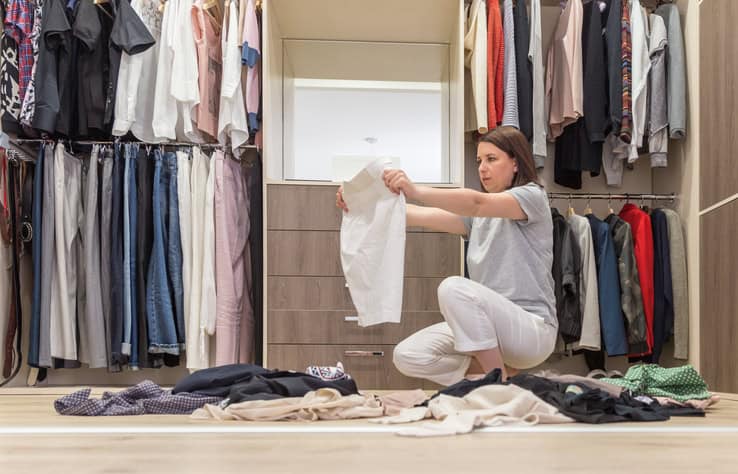
Is your closet ready for a spring make-over? Have you ever thought how great it would be to organize your closet with a professional organizer? Recently, I have been organizing lots of closets. There is something very satisfying about creating order in a closet. I love the look on my clients’ faces as we work together to make their closet functional for them. Each of them at one time or another during the process said, “I never would have thought of doing that”. As a professional organizer I can look at the space objectively and provide lots of different storage options.
During the year our closets can become a place to shove things to get them out of the way and maybe even hide them. If you have shelves in your closet, you can tuck small gifts in there – just for now. Then, I bet, you forget about them. The floor is another great place to stack things, particularly if you don’t have many long hanging clothes or if you keep your long hanging garments in another closet. You can close the closet door or just ignore the stacks of things on the floor under your clothes. At least those things are out of the way. How long do you leave them sitting on the floor before you take a second look?
Reasons to organize your closet with a professional organizer
Take everything out of the closet
It is overwhelming to contemplate removing everything from your closet. First, there’s no denying it is physically difficult work. There’s lots of reaching, carrying, and stretching involved. Working with a professional organizer is motivating. You want to make the best use of the organizer’s time. Think about where in the closet you want to begin.
I always suggest tackling the closet in sections. If you have a walk-in closet, tackle one wall at a time. Only put back the things that will belong on that wall or in that section.
Have a donation bag or box handy as well as a bag or box for things to take to be cleaned or fixed.
If you are not working with a professional organizer, find a friend to do this with you. Once your closet is organized, you can help with your friend’s closet.
Tactile sympathy
Do you know about tactile sympathy? This is when you touch or hold something that belongs to you and you become more reluctant to let it go even if you think it’s past time to do so.
You can avoid tactile sympathy regarding the clothes in your closet if you are working with a professional organizer.
The organizer can hold up a clothing item and you can say whether it stays or goes. If you can’t decide, the organizer can ask you questions like:
When was the last time you wore this garment?
Does it still fit?
It’s much easier to release clothes from your closet when you are not handling them yourself.
Zone out your closet
Talk through the way in which you like to access your clothes with the professional organizer. Let them know if you like to have jackets with their matching pants or if you like to have your favorite hoodie in the front of your closet.
Best practices suggests that we group clothes by type.
Your best practice may be that you like certain clothes grouped together because you wear them all the time.
Make it easier to find the clothes you want to wear by creating zones for large categories of clothes.
In one of the closets I recently worked we created a place for short-sleeve and sleeveless tops and a separate place for long sleeve tops. Once we had the tops in their zone we grouped by color.
My client was thrilled and amazed simultaneously. She had no idea she had so many white tops. Why? Because they had been hiding since they were mixed in with all the other colors. Now when she is thinking of wearing a white top she knows where to look.
How much is enough?
Sometimes when we’re out at the mall and see a cute shoe, top, dress (you can fill in the blank) we buy it because we like it (particularly if it is on sale) and because we can’t remember if we have something similar in our closet already. This occurs when we can’t easily see categories of clothes or shoes.
As we sorted the shoes in one of my client’s closets, we found about 10 pairs of black shoes. My client readily agreed that she did not need to have 10 pairs of black shoes. After she tried them all on, she released 3 pairs because they didn’t fit well. She also agreed that if she hasn’t worn a pair of these shoes during the next 12 months, she will donate them.
As you organize your closet determine how many of each type of clothing you want to have in your closet.
If you find you have an abundance of a certain category, promise yourself to shop in your closet before you shop in the mall.
What sort of hangers do you want to use?
Slim line hangers are great because they save space. The thicker hangers are bulky and take up more space than necessary.
Fabric hangers prevent clothes from slipping off the hanger. These are great for silky tops, pants, and jackets.
Did you know that you can return wire hangers to your local dry cleaners? Yes. They will usually take the hangers back and either use them or recycle them for you.
Use wooden hangers for things that are heavy like winter coats.
If you are thinking about replacing your hangers, you don’t need to replace all of them at once. That can be an expensive undertaking. Consider replacing them in one section of your closet at a time.
What to do with seasonal clothes?
Some closets are big enough to keep the cold weather clothes and warm weather clothes out year round.
I don’t switch out my clothes because winter is not terribly cold nor does it last very long here in Atlanta.
If space is tight use underbed storage drawers to contain out of season clothes. A second option is to fold the clothes and put them in a water tight plastic bin in the garage. A third option is to put the clothes into space saver bags and keep them on the top shelf of a closet.
What goes in the drawer, in a bin, or on a shelf?
As you organize your closet with a professional organizer you may come across things you can keep in a drawer, in a bin, or on a shelf. As you talk through the ways in which you want to access your clothes and accessories the organizer can suggest options to store things differently.
Consider file folding t-shirts and keeping them in a bin or drawer instead of hanging them in the closet.
The Container Store has a wide variety of storage options to use in a closet.
When you organize your closet with a professional organizer you are working with an objective professional. Chances are the organizer will have lots of suggestions for you. The most important thing for you to do is be honest. Tell the organizer how you want to find your clothes so they can tweak the system to fit your needs. If this is something you want to do on your own or with a friend join the Clear Space for You virtual support group. Jonda Beattie and I will give you actionable steps to take each week and hold you accountable so that you finish the project and are happy with the results. If you want to work with a professional organizer and live in Atlanta, reach out to me for a complimentary phone consultation. Here are two other resources to find professional organizers in your area: https://challengingdisorganization.org; https://napo.net.
For more organizing tips like these sign up for my monthly newsletter.
Diane N. Quintana is a Certified Professional Organizer® ,a Certified Professional Organizer in Chronic Disorganization®, Master Trainer and owner of DNQ Solutions, LLC and co-owner of Release●Repurpose●Reorganize, LLC based in Atlanta, Georgia.


Great points and a wonderful article to point to for anyone wondering how sessions with an organizer can work.
I love your description, as this is exactly the way I work with my clients. When clients are new, I start off by putting them in a position of “guest” or “observer” so that I hold up each item so I can see how they make decisions without touching the items. Once we’ve spent a good 90 minutes on the process, I switch things up and let them touch the items to see how their interactions change (or don’t). Tactile sympathy (or as I learned it, kinesthetic sympathy) dovetails with the Endowment Effect, making it much harder for clients to let go of their possessions, even if we discuss how it all works, so going through everything that way first, then encouraging them to try things on (even shoes and accessories) when they couldn’t make a decision earlier takes it to the next level. Starting off with not letting them touch the items helps make so much progress from the beginning, so we don’t have to backtrack. (Meanwhile, I must be the only person who hates those skinny, velveteen hangers!)
I have worked with many clients and their closets. I found that the bigger the closet, the longer it takes to declutter. My clients with large closets seem to feel more overwhelmed during their decluttering process as well. Keeping a try-on pile for later so they could go through things privately helped them get through the clothes and organization easier.
I was just working with a client last week in her closet. I held up items for her to look at the size and tag, but tried to avoid giving her the garment to handle for that “tactile sympathy” reason. There is definitely something to that. Of course, if a person wants to touch and think about an object, I have no objection. But the process does seem to go a bit faster if I do most of the handling.
Usually we do set aside a “try on” pile, because this is often the best way to make a decision about some garments. I kept saying, “Do you love it? Do you love how you feel when you are wearing it?” No reason to clog up a closet with pieces we feel lousy in, right?
What a great picture of how we work with clients! I like to have my clients keep all extra hangers out of the main dressing closet. Keeping some by the dryer is great or extras in a coat closet for guests is important.